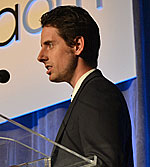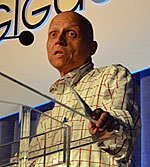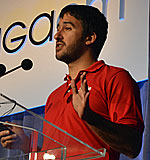
Tim Moreton, CEO, of Acunu, presents his pitch at the Launchpad competition at Structure.
GigaOM Structure offers an opportunity for tech start-ups to showcase their ideas through the Launchpad competition. The 11 finalists, representing some of the most promising new companies in the cloud computing sector, each made a four-minute pitch in front of the conference attendees and four judges. The first company to present, Acunu(seen above) has developed a storage stack that lets big data workloads make efficient use of modern, commodity hardware. Here's a look at the rest of the companies that presented.
 Solomon Hykes, Co-Founder and CEO, dotCloud |
Recognized by both the judges and audience as the winner of the compeitition, dotCloud is a new kind of Platform-as-a-Service (PaaS) that allows developers to run any major application or database stack in the cloud. dotCloud, a Y Combinator-funded company, allows developers to manage multiple kinds of applications running in different languages in one place. The service exited private beta last week. CEO Solomon Hykes also announced pricing starting at $99 a month for pro accounts. |
 Arijit Sengupta, CEO, BeyondCore |
BeyondCore offers scalability of business process outsourcing through a patented security solution, SplitSecure, which permits processing of information-security-regulated data. SplitSecure is a software-as-a-service solution that divides each transaction so that the individual pieces can be processed separately (even on separate cloud services). After each piece of the transaction is processed, it is then reassembled. |
 Kyle Forster, Co-Founder, Big Switch |
Big Switch Networks, with a team comprised of researchers from Stanford and veterans of Cisco, is building an OpenFlow-based platform that aims to bring the benefits of virtualization and cloud architecture to enterprise networks. Co-founder Kyle Forster described the company's approach as "like VMware, but for networking." The company is developing enterprise private cloud solutions. |
 Mat Ellis, CEO, Cloudability |
Cloudability is a platform that allows users to manage their cloud costs in one place. Cloudability aggregates usage and billing data from multiple cloud providers and provides an interface and daily email that provides a one-stop overview of the cost of your cloud workloads. The product is designed to prevent cloud cost overruns. "The cloud is infinitely scalable, but your dollars are not," said CEO Mat Ellis. |
|
The CloudControl application from Cloud Floor controls the operation of cloud applications, providing optimized visibility and control of cloud resources through a single dashboard. IT managers use their own KPI (Key Performance Indicators) to manage cloud services. CloudFloor says it provides real-time analysis of tradeoffs between cost, performance, resiliency and regulatory restrictions for cloud applications. It can manage assets on several cloud services, or across multiple zones. |
|
Genie DB presents a solution to large distributed database problems with a fabric that combines SQL and NoSQL for Platform as a Service providers and cloud providers. GenieDB is a distributed database that is both a MySQL storage engine and a high-speed document store. It provides SQL and NoSQL functionality to help application developers use the database more effectively and efficiently. |
|
PHP is a server-side scripting language that is the world's most popular method for delivering database-driven sites. PHP Fog is a Platform as a Service that brings the power of cloud computing to web developers who code in PHP. The PHP Fog service offers developers a quick and easy solution to avoid setting up and configuring servers. It offers "jumpstarts" to launch a WordPress, Drupal, Sugar CRM or Joomla application in minutes. |
|
Real-Status brings 3D to the cloud with its HyperGlance software, which provides modeling and visualization that depicts the relationship between physical and virtual assets. Using 3D visualization, a manager can model cloud infrastructure and visualize performance metrics and attributes for applications, networks, security, virtual machines. Real-Status is based in Cambridge, England. |
|
vCider is a startup that launched at the Structure conference, and offers a virtual switch for the cloud that allows users to connect all their physical and virtual systems, across multiple cloud providers and data centers, in a single virtual network. Systems on vCider virtual networks communicate using virtual addresses, which are separate and independent from the physical network to which they are attached. vCider users can control and manage all the nodes in their networks through a management console. |
|
Zerto is another startup that came out of stealth mode at Structure with backing from Battery Ventures and Greylock Partners. The company is developing business continuity and disaster recovery software for the cloud. By moving replication to the hypervisor layer, Zerto enables data replication on any virtual machine. End users can now protect any relevant virtualization elements, such as VMs, virtual disks, virtual networks and virtual applications, instead of less relevant physical elements. |






